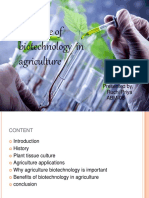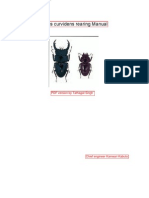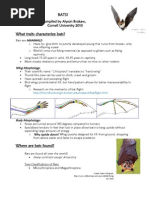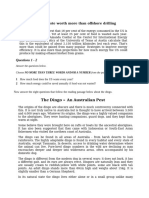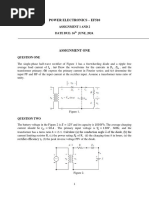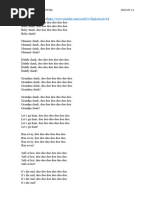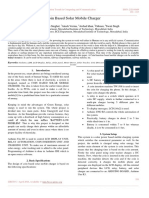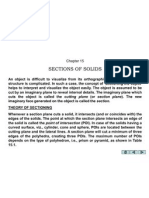Flying Mammals: Number 21
Flying Mammals: Number 21
Uploaded by
lastoutriderCopyright:
Available Formats
Flying Mammals: Number 21
Flying Mammals: Number 21
Uploaded by
lastoutriderOriginal Description:
Original Title
Copyright
Available Formats
Share this document
Did you find this document useful?
Is this content inappropriate?
Copyright:
Available Formats
Flying Mammals: Number 21
Flying Mammals: Number 21
Uploaded by
lastoutriderCopyright:
Available Formats
Number 21
People are becoming increasingly
aware of the importance of the
bats they once persecuted.
Increased pesticide use, the loss of
roosting and foraging habitat has
resulted in the current decline of
many bat species. North Carolina
supports 16 species of bats,
including three federally listed as
endangered.
This publication
provides information about bats,
their benefits, and steps
to
encourage bats on private lands.
The Importance of Bats
Bats serve as important pollinators
of many food plants as well as
provide useful aids for medical
research, particulary for the blind.
Distributed in furtherance
of the acts of Congress of
May 8 and June 30, 1914.
Employment and program
opportunities are offered to
all people regardless of
race, color, national origin,
sex, age, or disability.
North Carolina State
University, North Carolina
A & T State University, US
Department of Agriculture,
and local governments
Flying Mammals
Bats are the only mammals capable
of true flight. Their wings are like
hands with skin stretched between
modified finger bones. They are not
blind, but rely on echolocation
instead of their eyes for locating and
capturing food at night. Bats are
more closely related to primates
than the rodents with which they are
often compared. They have slow
reproductive rates with typically only
one offspring cycle. Like all other
mammals, female bats nurse their
young.
Bats are the only major predator of
night-flying insects. Bat prey
includes lacewings, cockroaches,
gnats, and mosquitos as their major
food source. A single Big brown bat
can eat between 3,000 and 7,000
mosquitos in a night, with large
populations of bats consuming
thousands of tons of potentially
harmful forest and agricultural pests
annually.
Permanent wet areas are critical
because they supply water and a
consistent insect supply.
North Carolina
Cooperative Extension Service
North Carolina State University
College of Agriculture & Life Sciences
College of Forest Resources
Page 2
Balancing Bat Habitat
A balance of foraging habitat and roosting habitat
is essential. Bats spend over half of their lives in
roosts and rely on sheltered, undisturbed natural
sites such as caves, crevices in rocks, and tree
cavities to meet their needs. In the winter
months, insulated roosts are important for
hibernating bats, while in late spring and early
summer, roosts that can sustain daytime
temperatures between 80 and 90 degrees
Fahrenheit are important for raising young bats.
Bats are somewhat opportunistic in their roost
selection and often utilize man-made structures
such as attics, abandoned houses, church lofts,
and barns where natural roosts are unavailable.
Install properly constructed artificial roosts in
areas were natural roosts are scarce or
absent. Solitary species such as the Hoary
bat will not use bat houses consistently as will
the colonial bats, which include the Little
brown bat, Big brown bat, and Eastern
pipistrelle. Use the following diagram to
build effective, maintenance-free bat
houses for roosting and raising young.
Promoting Bat Habitat
Encourage bats on your property by furnishing
foraging and roosting habitats in close proximity.
Maintain and manage snags in mature woodlots
to increase the availability of natural roosts.
Ensure foraging habitat by protecting all
permanent water sources such as beaver ponds,
swamps, marshes, and streams.
BAT HABITATS TO
PROTECT
Foraging
Beaver ponds
Marshes
Streams
Farmponds
Seasonal pools
Large drainage
ditches
River drainages
Roosting
Caves
Dead, hollow snags
Live cavitiy trees
Abandoned
homeplaces
Old stone chimneys
Crevices in rocks
Travel corridors
Basic Bat House Design
N.C. Cooperative Extension Service
Working With Wildlife # 21 - Bats
Page 3
Construction Tips
Place bat houses 10 to 15 feet off the
ground. Always seek assistance when
using folding or extension ladders.
Use cedar, cypress, or pressure-treated
pine lumber to insure durable, longer-lasting Locate boxes where they will absorb
boxes.
maximum sunlight. Where possible, place
four boxes per tree, one each facing North,
Use rough lumber, cut shallow grooves, or
South, East, and West, to allow the bats to
attach fine plastic or wire mesh to the inner
choose the box they need.
surfaces of the box so bats can easily crawl
up and into the house.
Install bat houses by early April. Dont
worry if bats do not begin using them
Avoid painting or varnishing the inside of the
immediately. A recent survey by Bat
house.
Conservation International (BCI) showed a
52% occupancy rate for all boxes. It may
Paint or cover the roof and the top four
take up to two years for bats to find and
inches of the sides with tar paper or another
begin using artificial roosts.
dark material to insure the high temperature
ranges required by both young and adult Inspect bat houses annually and remove
bats.
any vegetation that could interfere with
entry to the roost or allow predators to
Seal all seams with silicone caulk to
enter. Attach predator guards of roofing tin
waterproof houses and prevent heat and
on the mounting post or tree at a height of
moisture losses.
three feet to protect roosting bats from
house cats, raccoons, and snakes.
Installation Tips
Place bat boxes close to rivers, lakes,
ponds, marshes, or other permanent water
sources where insects are abundant.
Secure boxes to the sides of trees with a
ten penny nail or with crimped wire or a lag
bolt that can be loosened as the tree
grows. Boxes mounted on fast-growing
conifers may have to be remounted every
2 to 3 years.
Tilt houses at a 10 degree angle to help
young bats stay in the box.
North Carolina Bats
Brazilian
free-tailed bat
Big brown bat
Eastern
big-eared bat
Eastern
pipistrelle
Evening bat
Hoary bat
Indiana bat *
Little brown bat
Northern long-eared bat
Red bat
Small-footed bat
Seminole bat
Silver-haired bat
Southeastern bat
Virginia big-eared bat*
* Federally listed as Endangered
Prepared by:
Edwin J. Jones, Department Extension Leader,
Mark A. Megalos, Extension Forestry Specialist,
J. Chris Turner, Extension Associate
Page 4
References:
W.D. Webster, J.Parnell and W.C.Biggs, Jr. 1985. Mammals of the Carolinas,
Virginia, and Maryland. University of North Carolina Press, Chapel Hill.
Tuttle, M. and D. Hensley. 1993. The Bat House Builders Handbook.
Bat Conservation International, Inc., P.O. Box 162603, Austin, Texas 787162603
Virginia big-eared bat illustration on page 1 used with artists permission.
Other Wildlife Notes Available:
No. 1 - Endangered Species
No. 14 - Snags and Downed Logs
No. 2 - Eastern Gray Squirrel
No. 15 - Managing Edges for Wildlife
No. 3 - White-tailed Deer
No. 16 - Building Songbird Boxes
No. 4 - Songbirds
No. 17 - Woodland Wildlife Nest Boxes
No. 5 - Wild Turkey
No. 18 - Low Cost Habitat Improvements
No. 6 - Wood Duck
No. 19 - Pools for Amphibians
No. 7 - Cottontail Rabbit
No. 20 - Hummingbirds and Butterflies
No. 8 - Bobwhite Quail
No. 21 - Bats
No. 9 - Ruffed Grouse
No. 22 - Owls
No. 10 - Black Bear
No. 23 - Managing Beaver Ponds
No. 11 - Raccoon
No. 24- Herbaceous Plants for Wildlife
No. 12 - Mourning Dove
No. 25- SIP Wildlife Opportunities
No. 13 - Wildlife Terms
FOREST STEWARDSHIP
a cooperative program for
improving and maintaining all of the
resources on private forestland
10-94-4M-WWW-21
You might also like
- Taiyo - AI - Data Engineering (Web Scraping) Trial TaskDocument9 pagesTaiyo - AI - Data Engineering (Web Scraping) Trial TaskSavnesh Prajapati0% (1)
- Jordan Witzel's Master's ThesisDocument12 pagesJordan Witzel's Master's ThesisAnonymous NbMQ9YmqNo ratings yet
- Kenaf and Hemp Identifying The Differences by Thomas A. RymszaDocument5 pagesKenaf and Hemp Identifying The Differences by Thomas A. RymszaSamuel Nitisaputra100% (1)
- How To Grow Sugar Baby Watermelon - Guide To Growing Sugar Baby WatermelonDocument3 pagesHow To Grow Sugar Baby Watermelon - Guide To Growing Sugar Baby WatermelonetanksleyNo ratings yet
- CriketsDocument17 pagesCriketsAchmad InotNo ratings yet
- Law Insider Altisource Residential Corp Master Repurchase Agreement and Securities Contract Filed 09-11-2015 ContractDocument186 pagesLaw Insider Altisource Residential Corp Master Repurchase Agreement and Securities Contract Filed 09-11-2015 ContractmurthygraphicsbillingNo ratings yet
- FDIC Consumer Compliance Examination Manual - June 2022Document10 pagesFDIC Consumer Compliance Examination Manual - June 2022merNo ratings yet
- Japanese Beetle Fact SheetDocument2 pagesJapanese Beetle Fact SheetBranko StefanovskiNo ratings yet
- The Small-Scale Poultry Flock Table of ContentsDocument3 pagesThe Small-Scale Poultry Flock Table of ContentsChelsea Green PublishingNo ratings yet
- Types of MushroomsDocument8 pagesTypes of MushroomsKarina RossiNo ratings yet
- Creative Development in The Child The MoDocument324 pagesCreative Development in The Child The MoRaíssa SanasNo ratings yet
- ManuScript10 ETIGamma24Document69 pagesManuScript10 ETIGamma24wayne thompsonNo ratings yet
- Rearing Methods PDFDocument5 pagesRearing Methods PDFjocyeoNo ratings yet
- Watering TreesDocument2 pagesWatering TreesSharad BhutoriaNo ratings yet
- Breeding WaxmothsDocument3 pagesBreeding WaxmothsTam ElliottNo ratings yet
- Gardening For BeginnersDocument20 pagesGardening For Beginnersronalit malintadNo ratings yet
- Types of Fungal Fruiting BodiesDocument5 pagesTypes of Fungal Fruiting BodiesCaesar BrunoNo ratings yet
- Musca and StomoxysDocument8 pagesMusca and StomoxysransinghNo ratings yet
- Electroculture Permaculture Course Part 1Document24 pagesElectroculture Permaculture Course Part 1ascendintoabundanceNo ratings yet
- Culturing MealwormsDocument2 pagesCulturing MealwormsKamalNo ratings yet
- Learn Electroculture Troubleshooting Tips Guidebook by Aether Garden TechnologiesDocument43 pagesLearn Electroculture Troubleshooting Tips Guidebook by Aether Garden TechnologiesascendintoabundanceNo ratings yet
- Biotech ApplicationDocument45 pagesBiotech ApplicationKumud KumNo ratings yet
- Proceedings of Gen 98 Sci eDocument1,274 pagesProceedings of Gen 98 Sci ejonho2006No ratings yet
- Importance of MushroomDocument2 pagesImportance of MushroomSalai Lh100% (2)
- JER 39 (4) Published - Beetles and Forensic-Madhu Bala and Neha Singh - 1-1-2016 PDFDocument11 pagesJER 39 (4) Published - Beetles and Forensic-Madhu Bala and Neha Singh - 1-1-2016 PDFYanna RizkiaNo ratings yet
- TreeSeedTechnologyTrainingCourse InstructorsManualDocument162 pagesTreeSeedTechnologyTrainingCourse InstructorsManualJulio Mora CastilloNo ratings yet
- Ben Harden Method of Raising Honey Bee Queen CellsDocument4 pagesBen Harden Method of Raising Honey Bee Queen CellsOdprirodeNo ratings yet
- The Mushroom Growing Guide: Access Our Online Guides LibraryDocument8 pagesThe Mushroom Growing Guide: Access Our Online Guides LibraryFk a UsernameNo ratings yet
- Cyclic Codes: Generation of Cyclic Codes: A) Nonsystematic Cyclic Codes: (Multiplicative)Document11 pagesCyclic Codes: Generation of Cyclic Codes: A) Nonsystematic Cyclic Codes: (Multiplicative)Margoob TanweerNo ratings yet
- Ookuwagata Rearing Manual (Stag Beetles Rearing Manual)Document25 pagesOokuwagata Rearing Manual (Stag Beetles Rearing Manual)Tathagat_No ratings yet
- Securities and Exchange Commission: Vol. 80 Tuesday, No. 31 February 17, 2015Document26 pagesSecurities and Exchange Commission: Vol. 80 Tuesday, No. 31 February 17, 2015MarketsWikiNo ratings yet
- Indoor Fishing FarmDocument4 pagesIndoor Fishing Farmwaqasnaeemalik100% (1)
- Sept 2013 Enchanted Forest MagazineDocument58 pagesSept 2013 Enchanted Forest MagazineEnchantedForrestNo ratings yet
- Double Fertilization in PlantsDocument24 pagesDouble Fertilization in PlantsAshmit Srinjoy DuttaNo ratings yet
- Need For A Public Doubled Haploid Facility ?Document23 pagesNeed For A Public Doubled Haploid Facility ?Biotech Dr. Imran aliNo ratings yet
- 2 Elements of Sustainable Agriculture KopieDocument31 pages2 Elements of Sustainable Agriculture KopieAlberto CamachoNo ratings yet
- Funding For Small-Scale Farms: Tips For Grant and Loan ProposalsDocument4 pagesFunding For Small-Scale Farms: Tips For Grant and Loan ProposalsNhialNo ratings yet
- Linda Chalker Scott Compost TeaDocument3 pagesLinda Chalker Scott Compost TeauncleadolphNo ratings yet
- IPM MealybugsDocument24 pagesIPM Mealybugskumail100% (1)
- Weed of The Month Reed Canary Grass 000710Document1 pageWeed of The Month Reed Canary Grass 000710Nate OhNo ratings yet
- US Congress - How Investment Funds Became The New Insider Trading Risk - Financial TimesDocument13 pagesUS Congress - How Investment Funds Became The New Insider Trading Risk - Financial TimesAleksandar SpasojevicNo ratings yet
- Habitat Requirements Cover: Rabbit FoodsDocument4 pagesHabitat Requirements Cover: Rabbit FoodslastoutriderNo ratings yet
- Cottontail Rabbits in Relation to Trees and Farm Crops Farmers' Bulletin 702From EverandCottontail Rabbits in Relation to Trees and Farm Crops Farmers' Bulletin 702No ratings yet
- Wildlife Lab-Large Brown Bats Stockton University: Alex Epifano, Aysia GandyDocument7 pagesWildlife Lab-Large Brown Bats Stockton University: Alex Epifano, Aysia Gandyapi-301790589No ratings yet
- Yellow-Breasted ChatDocument2 pagesYellow-Breasted ChatConnecticut Wildlife Publication LibraryNo ratings yet
- WWW 22Document4 pagesWWW 22lastoutriderNo ratings yet
- Talking Parakeets (Budgies) - Complete Manual on Their Care, Training and BreedingFrom EverandTalking Parakeets (Budgies) - Complete Manual on Their Care, Training and BreedingNo ratings yet
- Brown Garden SnailDocument6 pagesBrown Garden SnailyaaqootNo ratings yet
- Bat GuideDocument5 pagesBat GuideDbaltNo ratings yet
- Ecological Effects of Rat HabitatDocument16 pagesEcological Effects of Rat HabitatUmer BhattiNo ratings yet
- Cavity Nesters Need Homes: Number 17Document4 pagesCavity Nesters Need Homes: Number 17lastoutriderNo ratings yet
- Habitat Requirements Food: Seasonal Foods of Gray SquirrelsDocument4 pagesHabitat Requirements Food: Seasonal Foods of Gray SquirrelslastoutriderNo ratings yet
- White-Tailed DeerDocument2 pagesWhite-Tailed DeerConnecticut Wildlife Publication LibraryNo ratings yet
- Facts About BatsDocument8 pagesFacts About BatsRAM KUMARNo ratings yet
- Document MightDocument4 pagesDocument MightharshmichaNo ratings yet
- American Kestrel Fact Sheet 2 2 4Document3 pagesAmerican Kestrel Fact Sheet 2 2 4api-252996168No ratings yet
- Document MightDocument2 pagesDocument MightharshmichaNo ratings yet
- US Food Waste Worth More Than Offshore DrillingDocument9 pagesUS Food Waste Worth More Than Offshore DrillingarpitchugghNo ratings yet
- Virginia Cooperative Extension: InstructionsDocument2 pagesVirginia Cooperative Extension: InstructionslastoutriderNo ratings yet
- VA 4H TreeID 5Document1 pageVA 4H TreeID 5lastoutriderNo ratings yet
- Habitat Requirements Food: Number 6Document4 pagesHabitat Requirements Food: Number 6lastoutriderNo ratings yet
- Virginia 4-H School Enrichment: ForestryDocument52 pagesVirginia 4-H School Enrichment: ForestrylastoutriderNo ratings yet
- Checklist of Virginia Trees and Their Uses: Note To 4-H Member GlossaryDocument2 pagesChecklist of Virginia Trees and Their Uses: Note To 4-H Member GlossarylastoutriderNo ratings yet
- Trees in Your Backyard: 4-H Forestry ProjectsDocument12 pagesTrees in Your Backyard: 4-H Forestry ProjectslastoutriderNo ratings yet
- Habitat Requirements Cover: Rabbit FoodsDocument4 pagesHabitat Requirements Cover: Rabbit FoodslastoutriderNo ratings yet
- Virginia Cooperative Extension: K T T I C #2Document1 pageVirginia Cooperative Extension: K T T I C #2lastoutriderNo ratings yet
- Trees: Edges Are ImportantDocument4 pagesTrees: Edges Are ImportantlastoutriderNo ratings yet
- Habitat Requirements Food: Seasonal Foods of Gray SquirrelsDocument4 pagesHabitat Requirements Food: Seasonal Foods of Gray SquirrelslastoutriderNo ratings yet
- WWW 11Document4 pagesWWW 11lastoutriderNo ratings yet
- Habitat Requirements Food: Number 5Document4 pagesHabitat Requirements Food: Number 5lastoutriderNo ratings yet
- Biological Diversity Community: CoverDocument4 pagesBiological Diversity Community: CoverlastoutriderNo ratings yet
- WHEPManual 2003Document52 pagesWHEPManual 2003lastoutriderNo ratings yet
- Habitat Requirements Food: Number 10Document4 pagesHabitat Requirements Food: Number 10lastoutriderNo ratings yet
- WWW 08Document4 pagesWWW 08lastoutriderNo ratings yet
- Habitat Requirements: Number 9Document4 pagesHabitat Requirements: Number 9lastoutriderNo ratings yet
- WWW 22Document4 pagesWWW 22lastoutriderNo ratings yet
- Key Habitat Areas: Number 18Document4 pagesKey Habitat Areas: Number 18lastoutriderNo ratings yet
- Key Foods: Habitat RequirementsDocument4 pagesKey Foods: Habitat RequirementslastoutriderNo ratings yet
- Cavity Nesters Need Homes: Number 17Document4 pagesCavity Nesters Need Homes: Number 17lastoutriderNo ratings yet
- Sexual Reproduction in PlantsDocument47 pagesSexual Reproduction in PlantslastoutriderNo ratings yet
- Pools For Amphibians: Number 19Document4 pagesPools For Amphibians: Number 19lastoutriderNo ratings yet
- Beaver Pond Benefits: Number 23Document4 pagesBeaver Pond Benefits: Number 23lastoutriderNo ratings yet
- Mowing and Brush Chopping: Number 24Document4 pagesMowing and Brush Chopping: Number 24lastoutriderNo ratings yet
- Introduction To Plant ReproductionDocument27 pagesIntroduction To Plant ReproductionlastoutriderNo ratings yet
- Plant Structures and FunctionsDocument49 pagesPlant Structures and FunctionslastoutriderNo ratings yet
- Cell Division: MeiosisDocument20 pagesCell Division: MeiosislastoutriderNo ratings yet
- Plant NutrientsDocument22 pagesPlant NutrientslastoutriderNo ratings yet
- GerminatDocument13 pagesGerminatlastoutriderNo ratings yet
- Over PotentialDocument5 pagesOver Potentialmohadese.abdoli327No ratings yet
- Research Paper 0333Document25 pagesResearch Paper 0333Ranjith GNo ratings yet
- Pop CultureDocument5 pagesPop CultureKyla JadjurieNo ratings yet
- Global Links ChapterDocument18 pagesGlobal Links Chapterapi-524155771No ratings yet
- Arcoweld Arcotig LCD HF 315acdc Operation Manual November2019 OnlineDocument44 pagesArcoweld Arcotig LCD HF 315acdc Operation Manual November2019 OnlineJederson ColaresNo ratings yet
- Guingona Vs City Fiscal of ManilaDocument6 pagesGuingona Vs City Fiscal of ManilaSu Kings AbetoNo ratings yet
- The Career Cartoonist - A Step-By-Step Guide To Presenting and Selling Your ArtworkDocument132 pagesThe Career Cartoonist - A Step-By-Step Guide To Presenting and Selling Your ArtworkRamiro Matone100% (6)
- MessageDocument53 pagesMessageRafael de LimaNo ratings yet
- Characteristics of Fuzzy Petersen Graph and Platonic Graph With Fuzzy RuleDocument7 pagesCharacteristics of Fuzzy Petersen Graph and Platonic Graph With Fuzzy RuleIJRASETPublicationsNo ratings yet
- 5038 - Assignment 2 Brief - Updated (With Numbers)Document7 pages5038 - Assignment 2 Brief - Updated (With Numbers)Minh Thu Nguyen TranNo ratings yet
- Assignment #1, B.Tech EE-V, Antenna & Wave PropagationDocument2 pagesAssignment #1, B.Tech EE-V, Antenna & Wave PropagationDr-Tarun ParasharNo ratings yet
- 1-Channel Digital Limit Switch Schuhmann MesstechnikDocument4 pages1-Channel Digital Limit Switch Schuhmann MesstechnikNguyen SonNo ratings yet
- Ef510 Assignment 1 2024Document4 pagesEf510 Assignment 1 2024Khondwani BandaNo ratings yet
- Pharm AnalysisDocument6 pagesPharm AnalysisMirumbi Kefa MomanyiNo ratings yet
- Caron wrapped in luxury crochet shawlDocument3 pagesCaron wrapped in luxury crochet shawlnya.s.hamidNo ratings yet
- MKT202 Group Report (Group 6)Document11 pagesMKT202 Group Report (Group 6)Al Amin Miajee 2031545630No ratings yet
- Biology: Revised Syllabus For Higher Secondary First Year CourseDocument4 pagesBiology: Revised Syllabus For Higher Secondary First Year CourseamitumikoibNo ratings yet
- Angol Dalok, MondókákDocument64 pagesAngol Dalok, MondókákBoglárka NagyNo ratings yet
- General Knowledge Facts of BangladeshDocument6 pagesGeneral Knowledge Facts of BangladeshParbon Acharjee100% (1)
- Titanium Dioxide, Black Phosphorus and Bimetallic Layer-Based Surface Plasmon Biosensor For Formalin Detection: Numerical AnalysisDocument16 pagesTitanium Dioxide, Black Phosphorus and Bimetallic Layer-Based Surface Plasmon Biosensor For Formalin Detection: Numerical Analysismichael.geller111No ratings yet
- All Rules For Blue and GrayDocument24 pagesAll Rules For Blue and GrayJavier GonzalezNo ratings yet
- Ep 10Document5 pagesEp 10Pratik BeheraNo ratings yet
- 3rd MB Meeting ArticleDocument2 pages3rd MB Meeting ArticleChristopher IgnacioNo ratings yet
- Coin Based Solar Mobile ChargerDocument3 pagesCoin Based Solar Mobile ChargerEditor IJRITCCNo ratings yet
- ML m1-m5 NOTESDocument160 pagesML m1-m5 NOTESchunchala.21ai833No ratings yet
- Radware ThreatReport Report 2024 RW-459Document59 pagesRadware ThreatReport Report 2024 RW-459bsotocNo ratings yet
- Handouts 01 IntroductionDocument2 pagesHandouts 01 Introduction1No ratings yet
- A Lost Fight Book: Alfred Lister and The Noble Art of Self-Defence in ChinaDocument25 pagesA Lost Fight Book: Alfred Lister and The Noble Art of Self-Defence in ChinaGeorge CisnerosNo ratings yet
- Section of SolidsDocument37 pagesSection of SolidsVivek SinghNo ratings yet





















